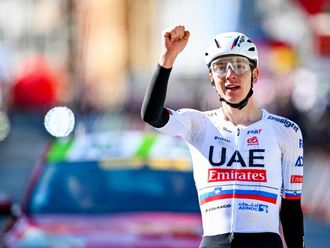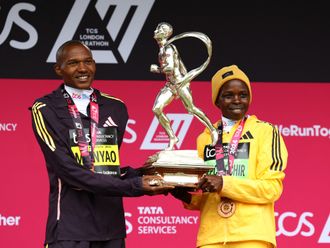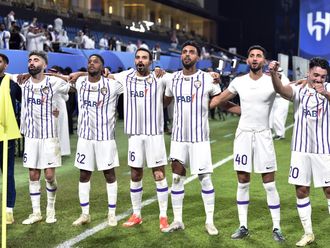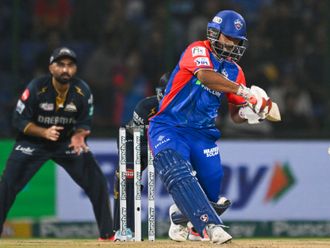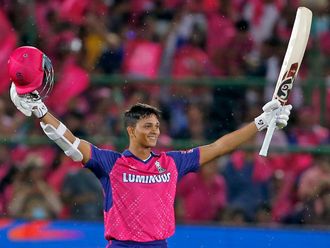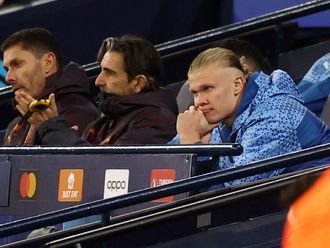Two boats have been dominant for the past decade and a half since the inaugural Sir Bu Naa'ir long distance sailing race was held in 1991.
Barraq, owned and skippered by Ahmad Rashid Mussabah Al Rumaithi, first won back-to-back races in 1994 and 1995.
Barraq won another two titles in 2001 and 2002 under new owner, Mussabah Rashid Al Fathan, while clinching the third spot in 2003.
However, Serdal owned by Shaikh Zayed Bin Sultan Al Nahyan and skippered by Ahmad Thani Al Rumaithi has the envious record of ending on the podium three years in a row.
Serdal's first glimpse of glory came on the trot in 1996 and 1997, while it had to stay content with third place overall in 1998.
This weekend, this spectacle of racing dhows, with their unfurled sails will carry the heritage of Arabic traditions dating back to the period when Dubai was known for its pearl merchants.
The Sir Bu Naa'ir Island represents a strategic point for the sailors, as it was used as a stopover for resting for the pearl diving boats, when they were en route back to Dubai from their long trips at sea.
Boats used the island to rest their crew, to clean and arrange the display of their pearls, ready for trading before their arrival in Dubai.
The Emirates pearl trade disappeared and sailing boats were deserted.
There were once around 400 words from the Arabic language that belonged exclusively to the sailor's dialect and are known only to seamen. These words have gradually disappeared from the local spoken language.
It was in an effort to revive this tradition that Shaikh Hamdan Bin Rashid Al Maktoum, Deputy Ruler of Dubai and Minister of Finance and Industry, decided to host the first race in 1991.
The Dubai International Marine Club [DIMC] emerged and started to play its role in safekeeping the roots of the previous generations and organised the first race on May 23, 1991.
That year, saw a fantastic fleet of some 53 dhows, in a range of various lengths and designs. The vessels were not all necessarily designed for a long-distance race, but it certainly represented the beginning of a new era for the dhow sailing activities in the Emirates.
This is how the Sir Bu Naa'ir race first found its origin, in this traditional route named Al Qaffal, meaning the journey back home, undertaken in the past by the traditional pearl boats.
This same route will be sailed this weekend for the 15th consecutive year.
Each year, this race attracts more participants and additional public interest.
The 54 Nautical Mile long distance race will start from the Sir Bu Naa'ir Island and finish at Jebel Ali Power Station this year.
The 90-odd registered boats will hoist their sails at 6.30am on Thursday from Sir Bu Naa'ir and are expected to finish by mid-afternoon.
With the soft hues of the rising sun in the background, a fleet of dhows with their sails not yet unfurled will be gently towed to the starting line of the 60ft traditional dhow sailing race at Sir Bu Naa'ir under the patronage of Shaikh Hamdan.
These races are a tribute that revive the traditions and cultural heritage of the United Arab Emirates.
It was way back in the mid 1980s, that Shaikh Hamdan initiated several programmes to maintain traditional dhows and conceived a sailing competition to help reaffirm the region's historic link to the sea.
The DIMC was entrusted with promoting the sport and has ever since organised several watersports events.
Ever since the first race was held in 1991, Shaikh Hamdan has made it a point to attend the preview of the races and encourage the participants with his presence.
The first races involved a few dhows that had survived from the days of old. Shaikh Hamdan tried to encourage these dhows without affecting the basic design used by their forefathers.
The one thing that always haunted some was the entry of outsiders to this traditional dhow race.
This year's race will have one dhow from Qatar. Shaikh Hamdan did not dispel the idea but recommended by saying that he welcomed outside participants, provided they met the dhow specifications.
He recommended they first have such races in their respective countries before participating in the UAE.
The UAE has over the years emerged as one of the leading countries in boat building. The best example is the Dubai-based Victory Team which stepped into commercial boat building.
With pride Shaikh Hamdan recently remarked: "Every country has something, which they specialise in these days. The Victory Team has set a good example by earning a name in powerboating and by entering the high-tech boat manufacturing industry."
Over the years these traditional dhow sailing races have witnessed the enthusiastic participation of youngsters who are being groomed into the tradition and culture of the land. A reminder of the vast heritage left behind by their forefathers.
At the Sir Bu Naa'ir races one sees at least three generations participating on one boat. The youngsters learn from the elders how to read the seas, the weather and navigation.
The members of each dhow rise very early to check the sails, scrutinise the mast damage and put the ballast weights in place.
The teams then begin the arduous job of getting the sail onto the mast and rolling it around the post. The whole process takes up to the early hours of the evening upon which, the team is ready to go for a trial run.
Saeed Hareb, DIMC Managing Director, said: "I used to race powerboats and buy the biggest outboard engines I could afford, but nothing compares to the experience of being under the sail. It is here that you feel the sea and the weather.
"At first it was the older generation that participated, men who knew the techniques of sailing from their jobs at sea and today the younger generation is actively searching for newer ways to preserve the tradition of dhow-building and racing, yet using modern technology," he added.
Sultan Hareb, Saeed Hareb's son, one of the skippers at the Sir Bu Naa'ir race said he will continue to participate as long as he can.
"It is a part of me. It's not a family matter, but a tradition that runs in me," he emphasised.
"We feel great that this tradition has been revived, it gives us a chance to experience our forefathers' way of living. This gives us a better understanding of how they supported our families and all the hardships they went through in order to give us what we have today," the youngster added.
"When the youth take part in these races, they actually relive what our ancestors have gone through. Shaikh Hamdan wants us to realise the importance of this race and the reason behind it being held from Sir Bu Naa'ir.
"Our forefathers travelled in those days without any entertainment, their only pastime were the songs they sang," Saeed Hareb interjected.
"The songs have come down from our ancestors and the younger generation does not understand them, even we do not at times. However, the songs are in praise of God for the weather, to thank Him for the good journey they have had or to pray for a pleasant journey onward."
These songs evoke in the sailors a sense of pride and to revive a lost heritage. The rhythm of the songs changes from time to time, according to the situation.
"The lyrics were composed by the older people several years ago and there is no written record of their origin or the composer," Saeed Hareb further informed.
But do the sailors have any emotional ties with their boats and the sea?
"Man needs the sea as much as the sea needs man. This, on a philosophical note, means that nature is one with man," Saeed Hareb added.
As the smoke rises from the flare marking the start of the race, there is a sudden and frantic burst




